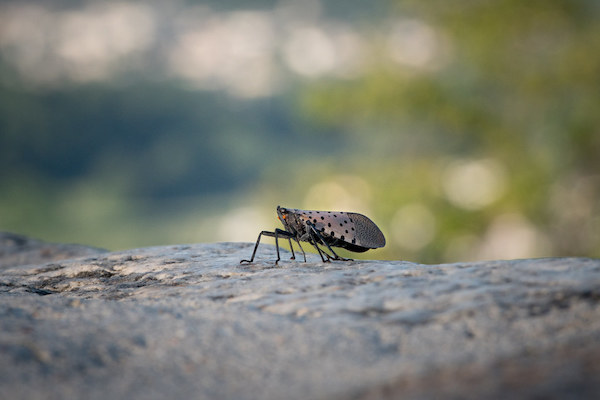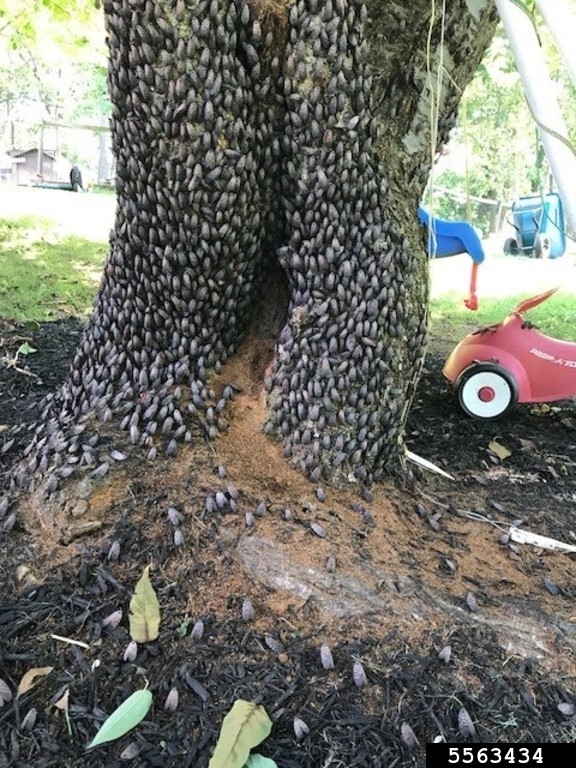
Scroll down to start.
By itself, you might think this is a rather pretty bug:

More than one becomes concerning:

Seeing the tree you planted look like this is downright alarming:

Meet the Spotted Lanternfly, the visitor from Asia that came to stay. When the insect was spotted for the first time in New York in 2020, experts knew they had a big problem because of what they’d seen happen in neighboring Pennsylvania; experts in that state had been dealing with the pest since 2014. These bugs leave behind them such a wake of destruction that one wonders why they haven’t been the topic of a Hollywood disaster movie: The bugs that ate New York.
They are invasive, sap-sucking planthoppers that cause massive amounts of damage to the host trees that support the bug during all of its life stages. In turn, the lanternfly releases honeydew that promotes black mold and fungi growth. In addition to attacking the vine trunk, shoots, and leaves of grape plants (think wine, not just edible grapes), the bugs attack 70 species of fruit trees and hardwoods. While they aren’t known to bite or sting, this insect can ruin an agricultural harvest. Initial estimates by economists at Penn State’s College of Agricultural Sciences tabulate Lanternfly damage at $50 million in economic losses each year, as well as 484 lost jobs just in southeastern Pennsylvania alone. A spread to the rest of Pennsylvania could lead to at least $324 million in damage annually as well as about 2,800 lost jobs.
There are no natural predators for the pest in the U.S. The only option to deal with them is to stop the eggs from hatching, and to do that, the eggs have to be found.
Enter the dogs.
Shane Philipps, who works at the Department of Agriculture, came up with the idea for canine lanternfly tracking. The University of Pennsylvania School of Veterinary Medicine’s Working Dog Center trained the first dog specifically to find the eggs of this cousin to cicadas and aphids, and a 19-month-old German Shepherd Dog named, “Lucky” was that dog. Since then, “Toby, a Small Münsterländer, has also been trained to detect the bugs, as well as a Labrador Retriever. The dogs will be used in a variety of situations such as roadside stops, industrial property, and goods inspections since the bugs can be found tucked into wheel wells, tree trunks, pots and crates.
In New York, Working Dogs for Conservation and the NY-NJ Trail Conference Conservation Dogs Program began training dogs to detect SLF adults and egg masses. The trained dogs have been working with NYS Parks, the NYS Department of Transportation, and NYS DAM to conduct cargo searches and field surveys for the Spotted Lanternfly.
The dogs have correctly identified egg masses with 95 percent accuracy while being able to ignore other potentially distracting scents 93 percent of the time. Do the dogs enjoy the work? Jennifer Essler, a postdoctoral researcher leading the project at the Penn Vet Working Dog Center says, “The dogs love it. Some people are like, ‘How can you make these dogs work?’ They were bred to work. If they don’t work, they go absolutely crazy. So we always try to place dogs in careers where they’ll be happy.”
Sounds like a win/win.
Update: This headline from March 16, 2021’s Atlas Obscura caught our eye: When Life Gave Pennsylvania Spotted Lanternflies, Its Bees Made Spotted Lanternfly Honey. Read the article here:
Image: Top image of German Shepherd Dog via Deposit Photo. Single Spotted Lanternfly image via Creative Commons. Remaining Spotted Lanternfly images by Lawrence Barringer/Department of Agriculture
